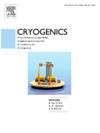低温容器多层绝热层瞬态传热特性的实验与模拟研究
IF 2.1
3区 工程技术
Q3 PHYSICS, APPLIED
引用次数: 0
摘要
低温容器的热保护系统需要适应各种条件,以保持热力学稳定性。考虑到多层保温层的瞬态传热行为对低温容器的热力学性能和运行安全起着至关重要的作用,在液氮温度下对90层多层保温层材料充注液氮后的瞬态传热进行了实验研究。建立并验证了包含间隔片非定常传热的改进瞬态仿真模型,以研究材料的瞬态传热特性。模拟了层间温度和热泄漏随时间的变化规律,并与实验结果进行了比较。研究表明,第30层、第60层温度和热泄漏均先快速下降后缓慢下降,其中热泄漏从0.42 W∙m−2下降到0.18 W∙m−2。第30层、第60层温度和热泄漏值与实验值的最大偏差分别为5.13%、4.78%和15.15%。修正模型的热泄漏预测精度达到±0.0182 W∙m−2,与最新参考模型相比提高了23.21%。漏热不受环境温度波动的影响,充氮后长时间保持在0.3 W∙m−2以下。该研究揭示了低温容器预冷过程中MLI瞬态传热特性,为低温工程应用中热防护系统的优化设计和提高计算精度提供了重要参考。本文章由计算机程序翻译,如有差异,请以英文原文为准。
Experimental and simulation study on transient heat transfer behaviour of multi-layer insulation for cryogenic vessels
The thermal protection systems of cryogenic vessels require adaptability under diverse conditions to maintain thermodynamic stability. Given that the transient heat transfer behaviour of Multi-Layer Insulation (MLI) critically determines the thermodynamic performance and operation safety of cryogenic vessels, an experiment study was conducted at liquid nitrogen temperature on the transient heat transfer of a 90-layer MLI material after liquid nitrogen filling. A modified transient-state simulation model incorporating the unsteady heat transfer of spacers was developed and validated to investigate the transient heat transfer characteristics of the material. The variations of the inter-layer temperatures and heat leakage with time were simulated and compared with the experiment. The study shows that the 30th, 60th layer temperatures and heat leakage all decrease first rapidly and then slowly, where the heat leakage decreases from 0.42 W∙m−2 to 0.18 W∙m−2. The maximum deviations of the 30th, 60th layer temperatures and heat leakage between the simulation and experiment are 5.13 %, 4.78 % and 15.15 %, respectively. The heat leakage prediction accuracy of the revised model reaches ± 0.0182 W∙m−2, which is improved by 23.21 % compared to that of the latest referenced models. The heat leakage is hardly affected by ambient temperature fluctuations, keeping below 0.3 W∙m−2 for a long period after liquid nitrogen filling. The study reveals the MLI transient heat transfer characteristics during cryogenic vessel precooling operations, and provides important references for optimizing thermal protection system design and enhancing computational accuracy in cryogenic engineering applications.
求助全文
通过发布文献求助,成功后即可免费获取论文全文。
去求助
来源期刊

Cryogenics
物理-热力学
CiteScore
3.80
自引率
9.50%
发文量
0
审稿时长
2.1 months
期刊介绍:
Cryogenics is the world''s leading journal focusing on all aspects of cryoengineering and cryogenics. Papers published in Cryogenics cover a wide variety of subjects in low temperature engineering and research. Among the areas covered are:
- Applications of superconductivity: magnets, electronics, devices
- Superconductors and their properties
- Properties of materials: metals, alloys, composites, polymers, insulations
- New applications of cryogenic technology to processes, devices, machinery
- Refrigeration and liquefaction technology
- Thermodynamics
- Fluid properties and fluid mechanics
- Heat transfer
- Thermometry and measurement science
- Cryogenics in medicine
- Cryoelectronics
 求助内容:
求助内容: 应助结果提醒方式:
应助结果提醒方式:


